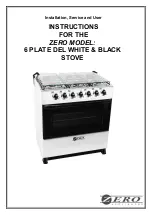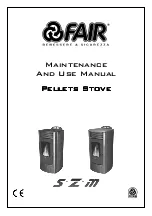
Townsend Freestanding
Townsend Freestanding
11
4
Installation
(continued)
Baffle System
The Jindara Townsend’s baffle system comprises of two components:
•
8mm Upper Baffle Plate
•
6mm Lower Baffle Plate
When removing the baffle system to clean the flue, the baffle system must be inspected and replaced in the configuration
as shown in Figures 3 and 4 (page 5).
If the system components are compromised in any way it is important the components are replaced.
Baffle removal is carried out in the reverse order of baffle installation.
Fitting the Baffle System
1.
Upper Baffle:
A.
Lift the Upper Baffle into place by reaching through the door opening, orientated with the folded edge pointing
down (1).
B.
Lift the back edge of the baffle up, and to the rear of the firebox (2), resting the rear of the baffle on baffle hanger
‘A’.
C.
Once the rear of the baffle is resting on baffle hanger ‘A’, bring the front of the baffle plate up and towards the
very front of the firebox. Rest the folded edge down into baffle hanger ‘B’, and ensure a secure snug fit (3).
1
2
3
Upper Baffle
B
A
Figure 3
Cleaning your Flue
It is recommended that you seek the services of a licensed plumber to carry out flue maintenance.
Firstly and carefully remove the firebox baffles and set them aside, following the instructions given on pages 4 & 5. Close
the heater door. Obtain a 150mm flue brush from you local Jindara dealer. Proceed to a position where you can access
the flue cowl, and remove it from the flue. Follow the instructions provided with your flue brush to assemble it, slowly
push the brush down the chimney until it stops. Pull the brush back through and repeat the process. Each time you do
this, you will notice the brush will go further down the chimney until it reaches the bottom, as the dislodged soot and
creosote falls down the chimney into the firebox. Ensure that you re-fit the flue cowl when you have finished cleaning the
flue. Clean the residue from the firebox and re-fit the baffles and other components, as per the instructions in the relevant
sections of this manual. Make sure the flue is cleaned thoroughly, as creosote will take longer to re-form in a well cleaned
flue, compared to one left with residual creosote build up.
Inspecting the Baffles
It is recommended that your heater baffles be inspected at least once a year, more often if your heater is operated for
more than six months of the year. A convenient time to do this is when your are cleaning the flue.
The baffles should be free from deformation or bowing, and there should be no holes in the steel (excluding the tertiary
air slots in the Lower baffle).
If the baffles are compromised in any way, they should be replaced. Operating your heater with defective baffles will
lead to losses in efficiency and heat output, and will also lead to high flue temperatures. Operating your heater with
a compromised baffle system, or without either of the baffles, will likely result in premature wear of the heater, and is
deemed to be misuse of the appliance.
Maintaining the Door Seal
To maintain efficient and safe use of your Jindara wood heater, you may need to adjust the door handle tightness. It is
important that you periodically check the door seal, to ensure that it is sealing against the face of the firebox at all points
when the door is in the closed position. If the door seal is excessively worn or damaged and unable to seal adequately,
you will need to replace it.
Adjusting the Door Handle
•
Open the door to gain access to the retaining screw.
•
Using an M 2.5 hex key, remove the retaining screw.
•
Looking from the front of the door, rotate the handle counter-clockwise to tighten the door catch, or clockwise to
loosen the door catch.
•
Once the desired setting has been achieved, re-fit the retaining screw.
Maintaining & Servicing your Jindara Wood Heater
!
WARNING
IT IS RECOMMENDED THAT YOU SEEK THE SERVICES OF A LICENSED
PLUMBER TO CARRY OUT FLUE MAINTENANCE.
THE BAFFLE SYSTEM IS A CRITICAL PART OF YOUR HEATER. IF THE BAFFLE
SYSTEM IS DAMAGED, BURNT OUT, DISCARDED, OR NOT INSTALLED AS PER
THESE INSTRUCTIONS, POOR PERFORMANCE AND EXCESSIVE FIREBOX AND
FLUE TEMPERATURES CAN RESULT.
IF FIREBOX FAILURE, FLUE FAILURE, OR EXCESS DAMAGE TO THE APPLIANCE
OR ITS SURROUNDINGS IS REPORTED DUE TO INCORRECT INSTALLATION
OR OPERATION OF THE BAFFLE SYSTEM, AF GASON PTY. LTD. RESERVE THE
RIGHT TO DISALLOW ANY WARRANTY CLAIMS IN RELATION TO THE ABOVE-
MENTIONED.
Maintenance


























